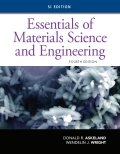
(a)
Interpretation:
The critical radius of the nucleus in the liquid iron needs to be determined.
Concept Introduction:
Homogeneous nucleation is the process in which the nuclei that are formed randomly and spontaneously grows irreversibly and form into a new phase.
In this question, we need to calculate the critical radius of the nucleus.
The critical radius of the nuclei is the minimum size of the nucleus required for the formation of a new stable nucleus.
Answer to Problem 9.20P
From the equation of the critical radius for the homogeneous equation, the value of the critical radius is
Explanation of Solution
Given Information:
From the parameter of the iron, values of different properties are:
Latent heat of fusion,
Surface free energy of solid-liquid phase,
Formula used:
The critical radius of homogeneous nucleation can be calculated by,
Calculation:
Temperature difference for undercooling,
Equilibrium solidification temperature,
The equation for the critical radius is,
Putting values in the equation,
(b)
Interpretation:
The number of iron atoms in the nucleus needs to be determined.
Concept Introduction:
Homogeneous nucleation is the process in which the nuclei that are formed randomly and spontaneously grows irreversibly and form into a new phase.
In this section, we need to calculate a number of atoms in the iron nucleus.
The nucleus consists of a different number of neutrons, protons, and electrons.
Answer to Problem 9.20P
From the equation of volume of the nucleus with a critical radius for the homogeneous equation, we get the value of a number of iron atoms in the nucleus is 350 atoms.
Explanation of Solution
Given Information:
The lattice parameter of solid BCC iron,
Formula Used:
The volume of the nucleus can be calculated by,
Calculation:
The volume of the unit cell,
The radius of the nucleus,
The volume of the nucleus,
Atoms per nucleus = (Number of the unit cell)
Want to see more full solutions like this?
Chapter 9 Solutions
Essentials of Materials Science and Engineering, SI Edition
- REMINDER: The truss must be cut into two different sections. You can choose either one to solve as you will get the same answer. Since there are three equations available, you can't cut more than three members 6.25 Determine the force in members BD, CD, and CE of the truss shown. BO C 36 kips 36 kips D F H 7.5 ft E G 4 panels at 10 ft = 40 ftarrow_forwardhelp on this one?arrow_forwardreaction at a is 1.6 wL (pos) handwritten solutions only please. correct answers upvotedarrow_forward
- Please show all the steps!arrow_forward10-3) similar to Lathi & Ding, Prob. P.6.3-7 The Fourier transform P(f) of a the basic pulse p(t) used in a certain binary communication is shown in the figure below: P(f) 1 0.5 0 f₁ = 0.8 √₂ = 1.2 f, MHz (a) From the shape of P(f), explain at what pulse rate this pulse would satisfy Nyquist's first criterion. (b) Assuming that the pulse is a raised-cosine pulse, find its rolloff factor. (c) Find p(t) and verify that this pulse satisfies Nyquist's first criterion in the time domain. (d) Show how rapidly the pulse decays as a function of t, (i.e., what power of t does the envelope obey for large time values).arrow_forwardDon't use ai to answer I will report you answerarrow_forward
- Don't use ai to answer I will report you answerarrow_forwardCalculate the area of the following polygon using the abscissa and projection method, taking into account the necessary adjustments before calculating the area of the polygon using the compass rule. Latitude Departure Side 930.63 N 930.63 S 1272 E 1271 W AB 122.14 E=12/2-1271-1 cr=-1 680 BC 173.83 length 591 CD 669.13 109.08 DE 139.36 961.1 EA 756.80 201.82 330.63/ 430.65 DEP=L SIN (O) >L DEP/SIN(O) LAT = L COS (0) DEPILATESIN(OYCOS (0)= TAN (0) O TAN-1 (DEP/LAT)= asztan Deptarrow_forwardDon't use ai to answer I will report you answerarrow_forward
 MATLAB: An Introduction with ApplicationsEngineeringISBN:9781119256830Author:Amos GilatPublisher:John Wiley & Sons Inc
MATLAB: An Introduction with ApplicationsEngineeringISBN:9781119256830Author:Amos GilatPublisher:John Wiley & Sons Inc Essentials Of Materials Science And EngineeringEngineeringISBN:9781337385497Author:WRIGHT, Wendelin J.Publisher:Cengage,
Essentials Of Materials Science And EngineeringEngineeringISBN:9781337385497Author:WRIGHT, Wendelin J.Publisher:Cengage, Industrial Motor ControlEngineeringISBN:9781133691808Author:Stephen HermanPublisher:Cengage Learning
Industrial Motor ControlEngineeringISBN:9781133691808Author:Stephen HermanPublisher:Cengage Learning Basics Of Engineering EconomyEngineeringISBN:9780073376356Author:Leland Blank, Anthony TarquinPublisher:MCGRAW-HILL HIGHER EDUCATION
Basics Of Engineering EconomyEngineeringISBN:9780073376356Author:Leland Blank, Anthony TarquinPublisher:MCGRAW-HILL HIGHER EDUCATION Structural Steel Design (6th Edition)EngineeringISBN:9780134589657Author:Jack C. McCormac, Stephen F. CsernakPublisher:PEARSON
Structural Steel Design (6th Edition)EngineeringISBN:9780134589657Author:Jack C. McCormac, Stephen F. CsernakPublisher:PEARSON Fundamentals of Materials Science and Engineering...EngineeringISBN:9781119175483Author:William D. Callister Jr., David G. RethwischPublisher:WILEY
Fundamentals of Materials Science and Engineering...EngineeringISBN:9781119175483Author:William D. Callister Jr., David G. RethwischPublisher:WILEY





